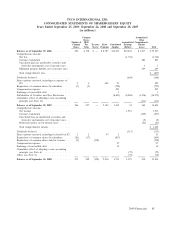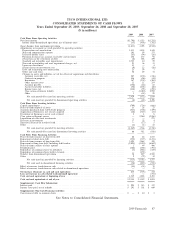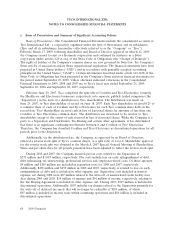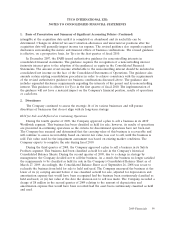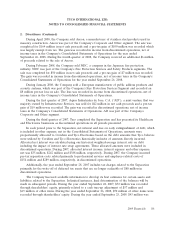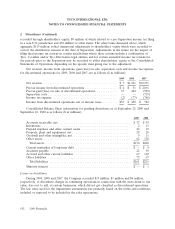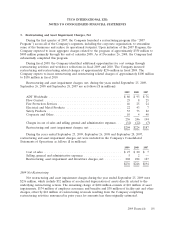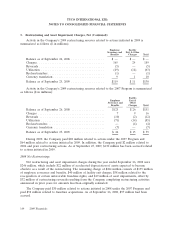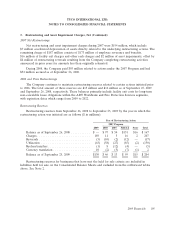ADT 2009 Annual Report Download - page 187
Download and view the complete annual report
Please find page 187 of the 2009 ADT annual report below. You can navigate through the pages in the report by either clicking on the pages listed below, or by using the keyword search tool below to find specific information within the annual report.TYCO INTERNATIONAL LTD.
NOTES TO CONSOLIDATED FINANCIAL STATEMENTS
1. Basis of Presentation and Summary of Significant Accounting Policies (Continued)
Environmental Costs—Tyco is subject to laws and regulations relating to protecting the
environment. Tyco provides for expenses associated with environmental remediation obligations when
such amounts are probable and can be reasonably estimated.
Income Taxes—Deferred tax liabilities and assets are recognized for the expected future tax
consequences of events that have been reflected in the Consolidated Financial Statements. Deferred tax
liabilities and assets are determined based on the differences between the book and tax bases of
particular assets and liabilities and operating loss carryforwards, using tax rates in effect for the years in
which the differences are expected to reverse. A valuation allowance is provided to offset deferred tax
assets if, based upon the available evidence, including consideration of tax planning strategies, it is
more-likely-than-not that some or all of the deferred tax assets will not be realized.
Insurable Liabilities—The Company records liabilities for its workers’ compensation, product,
general and auto liabilities. The determination of these liabilities and related expenses is dependent on
claims experience. For most of these liabilities, claims incurred but not yet reported are estimated by
utilizing actuarial valuations based upon historical claims experience. Certain insurable liabilities are
discounted using a risk-free rate of return when the pattern and timing of the future obligation is
reliably determinable. The impact of the discount on the Consolidated Balance Sheets as of
September 25, 2009 and September 26, 2008 was to reduce the obligation by $20 million and
$30 million, respectively. The Company maintains captive insurance companies to manage certain of its
insurable liabilities. Additionally, the Company records receivables from third party insurers when
recovery has been determined to be probable.
Financial Instruments—The Company may use interest rate swaps, currency swaps, forward and
option contracts and commodity swaps to manage risks generally associated with interest rate risk,
foreign exchange risk and commodity prices. Derivatives used for hedging purposes are designated and
effective as a hedge of the identified risk exposure at the inception of the contract. Accordingly,
changes in fair value of the derivative contract are highly effective at offsetting the changes in the fair
value of the underlying hedged item at inception of the hedge and are expected to remain highly
effective over the life of the hedge contract.
All derivative financial instruments are reported on the Consolidated Balance Sheets at fair value.
Derivatives used to economically hedge foreign currency denominated balance sheet items related to
operating activities are reported in selling, general and administrative expenses along with offsetting
transaction gains and losses on the items being hedged. Derivatives used to economically hedge
dividends declared in Swiss francs are reported in the Company’s Consolidated Statements of
Operations as part of other expense, net along with offsetting transaction gains and losses on the items
being hedged. Derivatives used to manage the exposure to changes in interest rates are reported in
interest expense along with offsetting transaction gains and losses on the items being hedged. Gains
and losses on net investment hedges are included in the cumulative translation adjustment component
of accumulated other comprehensive (loss) income to the extent they are effective. Gains and losses on
derivatives designated as cash flow hedges are recorded in accumulated other comprehensive (loss)
income and reclassified to earnings in a manner that matches the timing of the earnings impact of the
hedged transactions. The Company did not have any net investment or cash flow hedges during 2009.
The ineffective portion of all hedges, if any, is recognized currently in earnings as noted above.
Instruments that do not qualify for hedge accounting are marked to market with changes recognized in
current earnings.
2009 Financials 95


